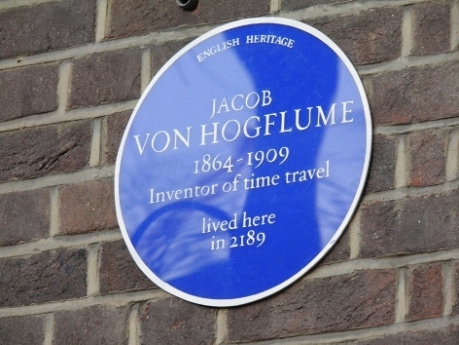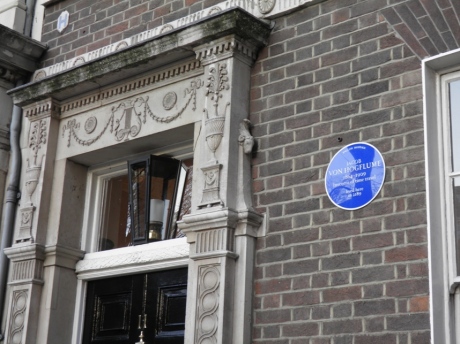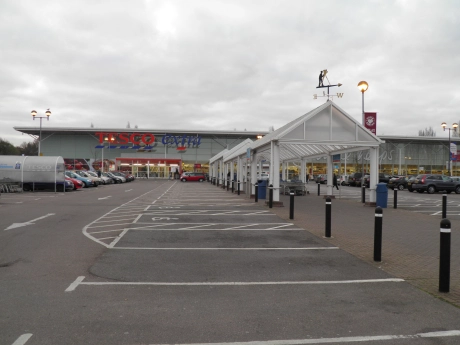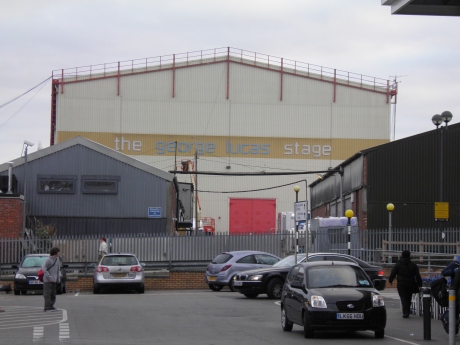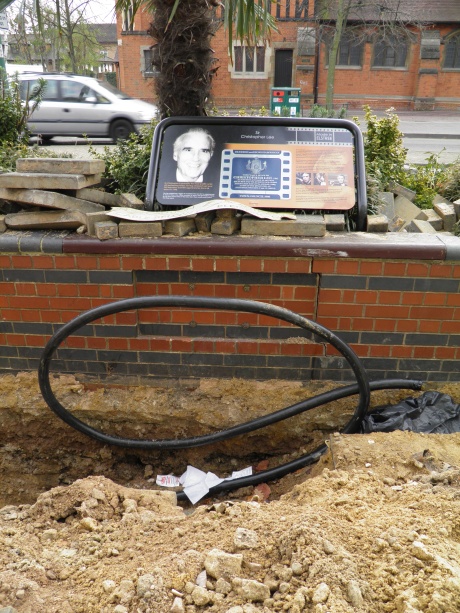Jacob Von Hogflume’s Blue Plaque
January 31, 2013
In February 2012, a blue plaque appeared on 11 Golden Square, Soho.
It’s not there anymore and neither was it up for long, which is a shame. It commemorated…well, have a look.
The plaque was the work of Dave Askwith and Alex Normanton, who made the signs look as authentic as possible and then surrepticiously secured them to buildings. Some lasted weeks, some months.
They released a book of their witty, realistic-looking work called Signs of Life in 2005. Now out of print, it’s available here on Amazon, or here on Abebooks if you can’t stomach non-tax-paying conglomerates.
It’s in the grand tradition of fake English Heritage signs which seem to be attracted to Soho – for many years, one was pasted to a window in Berwick Street reading “Tom Baker, Bespoke Tailor…worked here but lived round the corner” and for a while, Gavin Turk’s was displayed inside the Groucho Club – but I think this is my favourite. I’m all for it being made permanent.
A second Askwith-Normanton sign was on display a littler further down the wall when I took these photos. It too has now long gone.
A Tesco Far, Far Away
January 3, 2012
The vast Tesco in Borehamwood is probably the most famous supermarket in the London area.
Walking into it – and it’s more like walking into a small town than a supermarket – there’s little clue as to its claim to fame. But looking around, there are one or two hints.
On top of the covered walkway leading up from the huge, featureless car park is an unusual weather vane.
And if you look to your left when you reach the doors, there’s a much larger clue.
Before the mammoth Tesco was built, the site formed the backlot of Elstree Studios – the most important film studio in Britain during the 1960s and 1970s and today most famous as the location where the original Star Wars trilogy was filmed.
The image below shows the studios at the time Star Wars was filmed – to the right of the red line is where the Tesco stands today, while on the left is what remains of the studios, all largely untouched.
Opened in 1925 as the First National Studios by American JD Williams (who bought the site when it was informed it was “free of fog”), the 50 acres making up Elstree Studios are actually not located in Elstree, but Borehamwood. At the time, Borehamwood was little more than a few houses and a pub, so the railway station in the centre was named ‘Elstree’ after the better known nearby village (the station’s name eventually changed to Elstree and Borehamwood to reflect the town’s growth.)
In 1929, the first British talkie was produced at the studios – Blackmail, directed by a 30-year-old Alfred Hitchcock. A parallel silent version was also made, which proved more popular at the time, due to a lack of cinemas with the technology to broadcast the soundtrack.
As Elstree Studios – and the five rival studio complexes which sprang up in its wake – brought work to the area, Borehamwood grew into a larger town. It was dubbed the ‘British Hollywood’ during the 1950s and 1960s, when films including The Dam Busters, Look Back in Anger, Cliff Richard’s The Young Ones and Summer Holiday, Stanley Kubrick’s Lolita and Ice Cold In Alex were filmed in the six studios, side by side with a host of hugely successful TV series including The Avengers, Jason King, The Saint, The Champions and Randall and Hopkirk (Deceased).
In the early 1970s, the studio work started to slowly dry up – classic films like The Railway Children and A Clockwork Orange gave way to On The Buses and the Confessions of a Window Cleaner series, and the TV dramas deserted the studios for location shoots, taking a page out of the book of ITV’s hugely popular The Sweeney.
The similarly struggling Hammer production company moved from Bray to Elstree in 1967, and made a series of movies at the studios until they slid into bankruptcy in 1979. Aside from a handful of late classics (such as Quatermass and the Pit and One Million Years BC, remembered more for Raquel Welch’s fur bikini than anything else), the Elstree-vintage Hammer films began to ramp up the gore and nudity as the censors relaxed the code, and they had to compete with more gruesome horror fayre from America and Italy. 1976’s Dennis Wheatley adaptation To The Devil A Daughter was the final Hammer film made at the studios and it largely disappeared without trace at the box office.

The struggling studios were thrown a lifeline in 1975, when George Lucas decided to film Star Wars at Elstree (the first shot of the film was recorded in Studio 8, which is still standing today – when I was there, the ITV show Dancing On Ice was being loaded in.)
It was simply a stroke of good luck out of bad. Fox had little faith in the supposedly ‘dead’ genre of sci-fi, so wanted to hire somewhere cheap for what they thought would undoubtedly be a money-loser. Elstree’s studios were not just big enough to accommodate the massive scale of Lucas’s pre-CGI vision, but they were also empty and available at rock-bottom prices. And it wasn’t just Fox that had no faith in Lucas’s movie being a success – Elstree Studios were offered a flat-fee or a percentage of the profits of the film, and immediately plumped for the flat-fee.
Lucas returned again in 1979 to make The Empire Strikes Back, in 1982 to make Return of the Jedi, and over the years Willow, Labyrinth and the Indiana Jones series (having been taught a lesson about underestimating Lucas’s money-making ability by taking a flat-fee instead of a profit share with Star Wars, the studio amazingly rejected exactly the same offer when he made Raiders of the Lost Ark.) It was the era of the big studio-bound spectacular, and it would mark the high watermark of Elstree’s fortunes.
Lucas’s contribution to the studio’s fortunes are commemorated in the massive George Lucas Stage which was built in 1999, overlooking the Tesco where his movies were made. Popular legend has it that the scenes set on the ice planet of Hoth were filmed where Tesco’s frozen food aisle now sits. Inside, the corridors running between the huge cavernous studios are almost entirely featureless. It’s not exactly a magical place.
In 1978, Kubrick filmed The Shining at Elstree, building the entire Overlook Hotel interior on Stages 3 and 4, with the exterior constructed on the backlot, with mountains of salt standing in for snow. It all now forms part of Tesco’s car park.
In a bizarre piece of trivia, one of the runners on the film was a local boy from Elstree named Simon Cowell, who would go on to international fame twenty years later. Although none of his TV shows were filmed at Elstree, there is now a prominent plaque to Cowell outside – the first film he worked on was The Return of the Saint, so it’s at least tangentially appropriate that his tribute is next to one for Roger Moore.
Despite these bright spots, the productions were sporadic, and the studios went through a number of different owners through the years. The other studios amalgamated, moved or wound-up; today, only Elstree Studios and BBC Elstree (the long-term home of Eastenders) remain.
In 1988, following numerous takeovers and an ongoing decline in revenues, the studios were bought by the property developer Brent Walker, who had dabbled in movies under the Goldcrest name. Under the guise of modernising and compacting the virtually derelict studios, they demolished six of the nine studios and sold the entire (now empty) backlot to Tesco. Despite a pledge to operate the studios for 25 years, Brent Walker ran into financial difficulty and decided to close the doors in 1995.
For three years, they tried to sell off the derelict site for use as a shopping centre, with the main opposition to their plan coming from a local campaign named Save Our Studios, run by the council’s Entertainment Officer Paul Welsh. As a lifelong film buff and Borehamwood resident, Welsh had seen at first hand how the industry failed to preserve or value its own heritage. He told the Elstree Studios website:
I’ve seen things thrown into skips that you could cry about. I’ve seen scripts discarded, props from Star Wars that would cost a fortune now to buy abandoned, documents from Hitchcock’s Blackmail dumped into a skip. In the late sixties they had a library of screen tests that they’d done on actors of the 1930s. Richard Harris, Audrey Hepburn, Laurence Olivier, a whole cast of people who’d gone through the studio, and an executive of the time just stopped by and said, ‘what’s the purpose of keeping the junk?’ and they just scrapped it all.
Partly due to the pressure from Walsh, Brent Walker sold the site in 1996 to Hertsmere Borough Council for £1.9million. Since then, the studios have been renovated, and the TV side rejuvenated. Within a decade, the studios were the home of Who Wants to Be A Millionaire and the Big Brother house, which moved from East London into a vast sunken water tank at the back of the studios, which was originally constructed for 1955’s Moby Dick.
In recent years, the movies have also returned, with recent productions at Elstree including The King’s Speech, Saving Private Ryan, Batman Begins, The Other Boleyn Girl, Notes on A Scandal, Tomorrow Never Dies and Kick Ass.
The town’s fortunes have always been linked to the rise and fall of the nearby studios, and the long, steady decline in the British film industry over the last forty years have been reflected in the surrounding area. Nowadays, Borehamwood is a long, bleak strip of charity shops, orange-hued greasy spoons, tatty pawn shops and grim, boarded-up frontages.
In 2006, the town attempted to celebrate its unique connection to British cinema history with a series of semi-successful council-led displays. Along the roads are a series of metal information boards dedicated to the stars who worked at the studios.
Chock-a-block with history, they’re placed in large, unkept brick flower beds outside the pubs and 24-hour newsagents. When I was there, no one was paying them any attention at all, and most people looked at me with curious puzzlement when I took my camera out to photograph them.
On the High Street, large banners proclaiming “Made in Elstree” (although technically it should be “Made at Elstree” as the films were all made in Borehamwood) show stills from of the iconic movies made at the studios – hence, A Clockwork Orange’s Alex stares down menacingly at the old people shuffling past the pawnbrokers, Chewbacca growls at the traffic streaming over one of the countless traffic-slowing ramps, and Darth Vader flutters proudly over a branch of Nando’s.
At the railway station is a miniature walk of fame with one star commemorating Harrison Ford – the man who famously referred to the area as “Boring-wood.” A completely lackluster paving slab, it’s a fitting tribute.
In the Tesco itself, the only reminder of its former use is an aisle of Star Wars toys – situated not far from where the film which inspired them was created thirty years before.

